Panel 1
Andrea Gagna
The EPRTR (European Pollutant Release and Transfer Register) is the integrated register established by the EU based on Regulation (EC) No. 166/2006, aimed at making publicly available information on environmental impacts caused by industrial facilities falling under the criteria set out in the regulation.
This indicator represents total emissions into surface waters and pollutant transfers in wastewater from industrial facilities that reported such data to the national PRTR register. For the year 2020, 60 substances were reported as present in emissions into surface water bodies, while 49 substances were declared in pollutant transfers via wastewater conveyed through pipelines to external treatment facilities.
The PRTR activity groups that contribute the highest percentages of reported pollutant emissions into both wastewater and surface waters are generally those related to "Waste and Wastewater Management" and "Chemical Industry".
The indicator shows total emissions into surface waters (direct discharges) and total pollutant transfers in wastewater (indirect discharges) from large industrial facilities located across the national territory. Emission data also includes discharges from urban wastewater treatment plants with a treatment capacity of at least 100,000 population equivalents.
Water emissions and wastewater transfer data are obtained through measurements, calculations, or estimates as stipulated by the reference legislation. Qualitative and quantitative information is collected via PRTR declarations, based on the criteria set out in Regulation (EC) No. 166/2006, Presidential Decree No. 157/2011, and Article 30 of Legislative Decree No. 46/2014.
These criteria include a list of pollutants (Annex I of the Regulation), each with a reporting threshold for emissions to air, water, and soil. Unlike the former INES register, in the PRTR register, direct emissions to water and pollutant transfers via wastewater are managed and assessed separately according to the respective water matrix threshold.
L'indicatore rappresenta le emissioni totali nelle acque superficiali (scarichi diretti) e i trasferimenti totali di inquinanti nei reflui (scarichi indiretti) dei complessi industriali di maggiori dimensioni presenti sul territorio nazionale. I dati di emissione in acqua includono anche le emissioni derivanti dalla depurazione dei reflui civili (impianti di depurazione con capacità di trattamento pari ad almeno 100.000 abitanti equivalenti). I valori delle emissioni in acqua e dei trasferimenti di inquinanti nelle acque reflue riportati sono stati acquisiti tramite misure, calcoli o come previsto dalla normativa di riferimento. Le informazioni qualitative e quantitative sulle emissioni in acqua e sui trasferimenti di inquinanti nei reflui sono raccolte attraverso le Dichiarazioni PRTR sulla base dei criteri stabiliti dalla normativa di riferimento (Regolamento CE n.166/2006; DPR 157/2011 e art.30 del D.Lgs. 46/2014). Tali criteri consistono in una lista di inquinanti (Allegato 1 al Regolamento) a ciascuno dei quali è associato un valore soglia all'emissione in aria, acqua e suolo. A differenza del precedente Registro INES, nel Registro PRTR l'emissione in acqua (scarico diretto, cioè inviato direttamente al corpo idrico recettore superficiale anche dopo eventuale trattamento di depurazione interno) e i trasferimenti di inquinanti nelle acque reflue (scarichi indiretti, cioè inviati attraverso fognatura o condotta dedicata a un depuratore esterno) sono gestiti e confrontati separatamente con i valori soglia relativi alla matrice acqua per la dichiarazione.
The purpose is to provide qualitative and quantitative information on water emissions produced by PRTR activities (which also include most activities subject to the Integrated Environmental Authorization procedure under the IPPC Directive). For each pollutant and reference year, the national figures for emissions into surface waters and for transfers into wastewater are reported.
Regulation (EC) No. 166/2006; Presidential Decree No. 157/2011; Art. 30 of Legislative Decree No. 46/2014
The goal is to make environmental data publicly accessible. Compared to the previous INES register, the PRTR register covers more companies, more substances, and more monitored activities. The first national EPRTR data collection took place in 2008, referring to data from 2007. The register is updated annually and includes data from companies that were previously reporting to the INES register.
Panel 2
The data collection system for the PRTR Register, based on a self-declaration process by facilities and quality assessment by the competent authorities, allows room for actions aimed at further improving the completeness of the database. Quality control operations carried out by the competent authorities may result in subsequent adjustments to the reporting base and to the national figures for water emissions and pollutant transfers in wastewater.
Data quality assessment
ISPRA (Italian National Institute for Environmental Protection and Research)
The data on total emissions into surface water and transfers of pollutants in wastewater from facilities included in the official communication to the European Commission (Article 7 of Regulation (EC) No 166/2006) are publicly accessible on the EPRTR (European Pollutant Release and Transfer Register) website: https://industry.eea.europa.eu/#/home
National
2007-2020
Indicator assessment
The values are obtained by aggregating data by substance and by PRTR activity group.
In 2020, 60 substances were reported in emissions to surface water bodies. Most of these emissions originate from the "Waste and Wastewater Management" and "Chemical Industry" groups. No emissions were reported from intensive livestock farming or aquaculture activities. The "Waste and Wastewater Management" group contributes to nearly all substances, but for some (e.g., halogenated organic compounds), the highest contributions come from the "Miscellaneous" group (see Table 1, Figures 1–5). Compared to 2019, emissions of 26 substances increased, while emissions of 34 substances decreased.
For pollutant transfers via wastewater pipelines to external treatment facilities, 49 substances were declared in 2020 (Table 2). The main contributors were “Miscellaneous” and “Waste and Wastewater Management”. Compared to surface water discharges, the metal industry’s role increased (notably for cadmium and lead), and over 98% of chromium in wastewater came from the “Miscellaneous” group, particularly from the tanning industry (Table 2, Figures 1–5). Emissions for 28 substances decreased compared to 2019.
About the 60 substances reported for 2020 in surface water emissions, for 13 substances, there was insufficient data to determine a trend; for 29 substances, emissions decreased compared to 2007 (for 18 of these, the reduction exceeded 40%); for 18 substances, emissions increased compared to 2007 (14 had increases greater than 40%).
Regarding transfers via wastewater, for 13 substances, no comparison with 2007 was possible; for 14 substances, amounts increased compared to 2007 (11 had increases >40%); for 25 substances, amounts decreased (12 had reductions >40%).
Data
Table 1: Total emissions into surface waters, by PRTR group, in 2020
ISPRA, Italian National PRTR Register
Table 2: Total transfers of pollutants in wastewater, by PRTR group, in 2020
ISPRA, Italian National PRTR Register


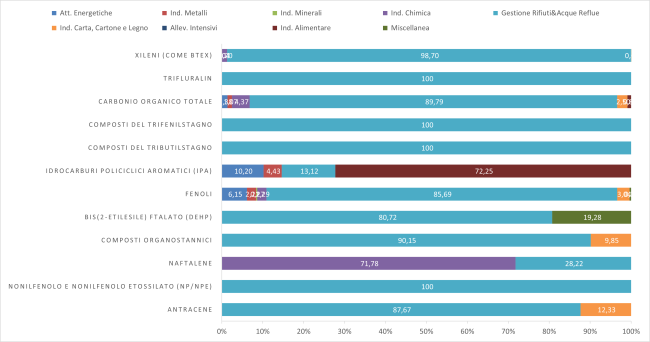

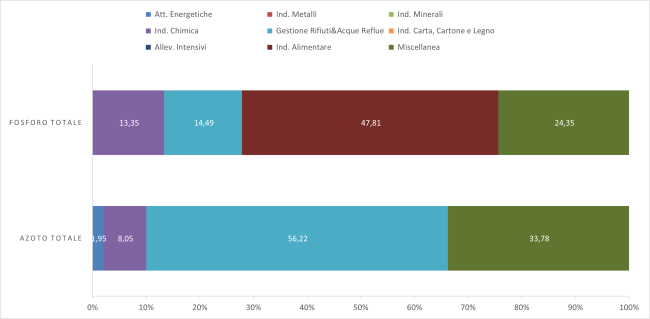

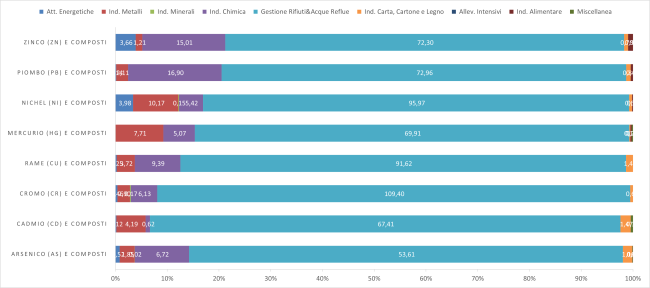
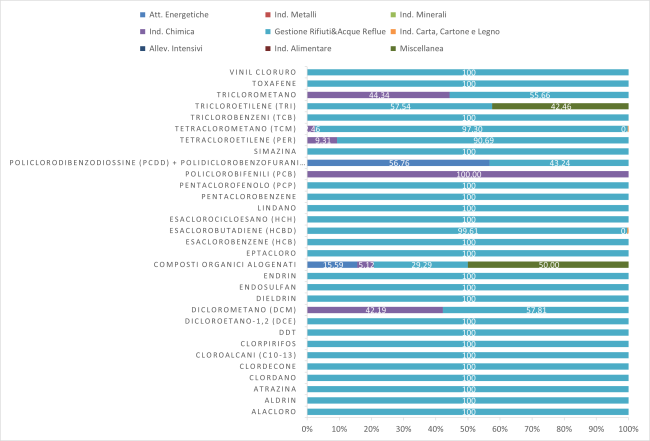
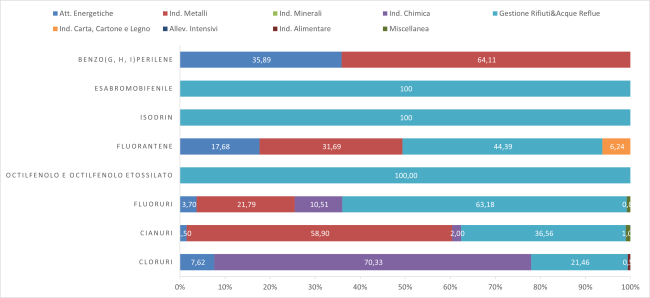
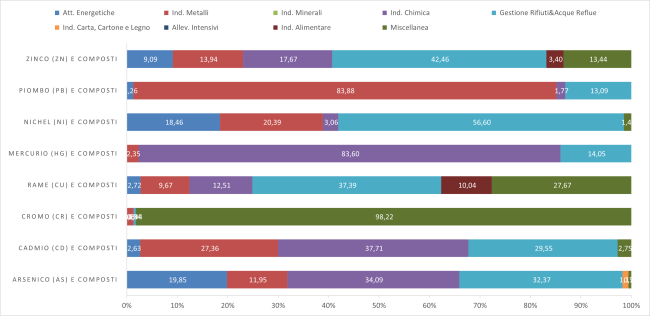

The national emission values reported in Tables 1 and 2 are obtained by aggregating the data declared by individual facilities subject to the obligation to report to the PRTR Register. The values for emissions into surface water bodies and pollutants transferred in wastewater refer to substances included in the list established by the relevant legislation. The data declared by individual facilities, having exceeded the corresponding thresholds set for PRTR reporting, were subject to quality assessment by the competent authorities. The substances listed in the tables indicate that, for the year considered, at least one facility reporting to the PRTR Register provided information regarding the parameter in question. Therefore, blank cells indicate that no data exceeding the threshold were reported for that substance and the year in question.